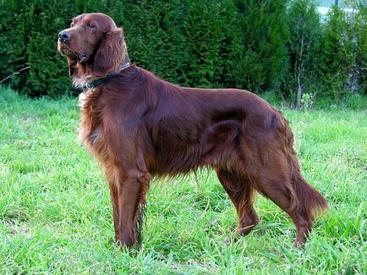
A descendent of the Spanish Pointer, the Irish Setter or 'Irish Red' as it is known in America, dates back to the mid-17th century. Its forbears are believed to be that of the English and Gordon Setters, Pointers, Irish Terrier and Water Spaniel. This distinctive breed is referenced in literature from 1570, although it is possible it evolved much earlier. Developed by the Irish gentry who wanted their own type of Setter that was easily seen in the field to hunt and retrieve with, the Irish Setter became a popular breed choice with lasting appeal. Officially recognised by the American Kennel Club in 1878.
With a specialism in hunting game birds, the Irish Setter is a versatile gun dog, well suited to working over difficult terrain in all manner of weather conditions. Its distinctive mahogany-red coat characterises the breed, distinguishing it from its red and white cousin. Boasting a well defined head, hanging pendant ears, a long tail and almond-shaped eyes, the Irish Setter is attractive and functional, adapted to its early working fulfillments. The coat varies in length, with short and fine hair on the head and on the front of the legs, and medium-length hair everywhere else. Feathering is seen on the ears, underside and on the back of the legs.
This sporting breed is both energetic and independent-minded, so firm leadership, early socialisation and consistent obedience training is essential from puppyhood. When trained, the Irish Setter has the potential to be a loyal and affectionate companion, adapting well to new situations and people and being responsive to instruction. A great breed choice for active families or the dedicated sole owner, providing its needs for regular human contact and exercise are met. On average, a Setter at full maturity will weigh 25-35 kg, with a life expectancy of 11-15 years when shown the appropriate care.
As with most breeds, hip and elbow dysplasia is a common ailment. The Irish Setter is also susceptible to immune deficiencies, various optical disorders and skin allergies. Ear infections and bloat, a potentially fatal condition if left untreated for any length of time, are also identified in the breed.








From Norfolk, United Kingdom
Fun faithful beautiful energetic enthusiastic and very intelligent